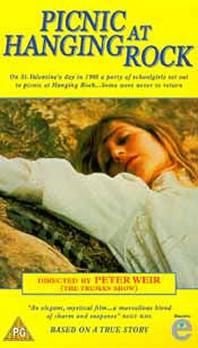
Rocky Road
The radical sheen of 'Picnic at Hanging Rock' has faded POE'S LINE "All that we see or seem is but a dream within a dream" serves as the epigraph for Australian director Peter Weir's 1975 hit, Picnic at Hanging Rock, now back in a new, shorter director's cut. The film takes place in six weeks during the peak of Australian summer, beginning on Valentine's Day, 1900. It's a Gothic story--implied more than told. Miss Appleyard's College in South Australia is a tightly run boarding school in which yearnings shoot back and forth like a current between students and staff. The center of the school's undifferentiated ardor is Miranda (Anne Lambert), an attractive blonde student likened to a Botticelli angel. As a treat for the girls, a picnic is arranged at a local promontory, a large volcanic rock honeycombed with caves. Mrs. Appleyard (Rachel Roberts) makes the excursion seem about as pleasant as a week at Castle Frankenstein: "The rock itself is extremely dangerous. ... The vicinity is renowned for its venomous snakes." About 18 of the students endure the heat there, grooming each other's hair and reading. Miranda and three other girls trot off for a hike and vanish, leaving behind a mystery that eventually cracks open Appleyard's haute-Victorian school as if it were the House of Usher.
Essentially, Weir was trying to make a film in which high noon was as haunted as midnight. Certainly, Picnic at Hanging Rock anticipates a lot of David Lynch's work; the killing of Laura Palmer shakes up the orderly community of Twin Peaks just as Miranda's vanishing brings out the cruelty and pain underneath the orderly, genteel surface of the boarding school. And Roberts, with a huge Turk's bonnet of styled gray hair and a frozen upper lip, is as grotesque in her way as any of Lynch's villains.
Why then is Picnic at Hanging Rock so much less enjoyable than Blue Velvet or Twin Peaks?
Is it because of the silliness of the transcendentalism--the suggestions that Miranda has evolved into a swan? The relentless sun seems to have made the girls aware of the infinite ( "Everything begins ... and ends ... at exactly the right time and place," one of them mutters). Lynch's usual model is of an ostensibly normal world that's plenty grotesque enough--and then this ostensibly normal world gets stormed by the antiworld of Lynch's weirdoes. Weir's film suggests something simpler and less interesting: becoming one with nature, discarding your corsets and heading for the hills.
Picnic has a mood, and the landscapes of roasting Austral forest are sometimes hypnotic. But Cliff Green's dialogue ("They might be out there, dying of thirst on that infernal rock") suggests Harold Pinter writing a Girl's Own Adventure, with plenty of pauses and meaningful glances between the students. While the pan-pipe soundtrack by the infamous Zamfir has aged the film greatly, what ages it even more is the thrill that the thought of these women's forbidden love for each other is supposed to give. (Younger lesbians might find the film sort of campy.) Today, Picnic at Hanging Rock seems only an especially well-photographed specimen of Vic-bashing, far less radical now than it might have been a quarter of a century ago.

Back to start of Hanging Rock section
My Index Page
|